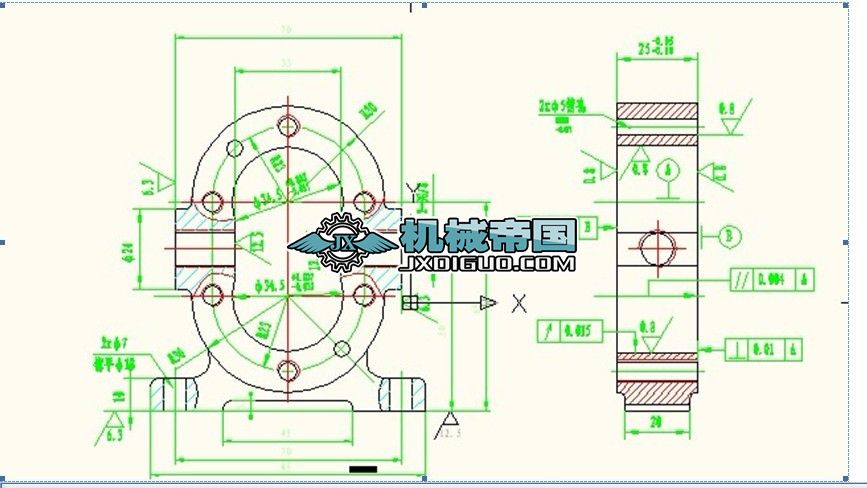閥體加工工藝規(guī)程及其鉆孔的夾具設(shè)計【機械制造課程設(shè)計文件】
- 文件介紹:
- 該文件為 zip 格式,下載需要 20 積分
-


- 閥體加工工藝規(guī)程及其鉆孔的夾具設(shè)計【機械制造課程設(shè)計文件】
摘 要
本次設(shè)計內(nèi)容涉及了機械制造工藝及機床夾具設(shè)計、金屬切削機床、公差配合與測量等多方面的知識。
閥體加工工藝規(guī)程及其鉆孔的夾具設(shè)計是包括零件加工的工藝設(shè)計、工序設(shè)計以及專用夾具的設(shè)計三部分。在工藝設(shè)計中要首先對零件進行分析,了解零件的工藝再設(shè)計出毛坯的結(jié)構(gòu),并選擇好零件的加工基準,設(shè)計出零件的工藝路線;接著對零件各個工步的工序進行尺寸計算,關(guān)鍵是決定出各個工序的工藝裝備及切削用量;然后進行專用夾具的設(shè)計,選擇設(shè)計出夾具的各個組成部件,如定位元件、夾緊元件、引導(dǎo)元件、夾具體與機床的連接部件以及其它部件;計算出夾具定位時產(chǎn)生的定位誤差,分析夾具結(jié)構(gòu)的合理性與不足之處,并在以后設(shè)計中注意改進。
關(guān)鍵詞:工藝、工序、切削用量、夾緊、定位、誤差。
Abstract
This design content has involved the machine manufacture craft and the engine bed jig design, the metal-cutting machine tool, the common difference coordination and the survey and so on the various knowledge.
Body process planning and drilling fixture was designed to include part machining process design, process design, and dedicated fixture design of three parts. In process design, analysis of the part must first understand the parts of the process re-engineering the structure of a blank, and select a good part of the processing of the base to design parts process route; followed by the various working steps on the part of the procedures for the size of the calculation, the key is to determine the various stages of work out of process equipment and cutting consumption; then dedicated fixture design, selection of design out of all the component parts fixture, such as the positioning components, clamping components, guiding elements, the specific folder connection with the machine parts and other components; calculate the positioning fixture positioning error generated, analysis fixture structure is reasonable and deficiencies, and attention to improving the design in the future.
Keywords: The craft, the working procedure, the cutting specifications, clamp, the localization, the error
第1章 緒論
1.1課題背景
隨著科學技術(shù)的發(fā)展,各種新材料、新工藝和新技術(shù)不斷涌現(xiàn),機械制造工藝正向著高質(zhì)量、高生產(chǎn)率和低成本方向發(fā)展。各種新工藝的出現(xiàn),已突破傳統(tǒng)的依靠機械能、切削力進行切削加工的范疇,可以加工各種難加工材料、復(fù)雜的型面和某些具有特殊要求的零件。數(shù)控機床的問世,提高了更新頻率的小批量零件和形狀復(fù)雜的零件加工的生產(chǎn)率及加工精度。特別是計算方法和計算機技術(shù)的迅速發(fā)展,極大地推動了機械加工工藝的進步,使工藝過程的自動化達到了一個新的階段。
“工欲善其事,必先利其器。”
工具是人類文明進步的標志。自20世紀末期以來,現(xiàn)代制造技術(shù)與機械制造工藝自動化都有了長足的發(fā)展。但工具(含夾具、刀具、量具與輔具等)在不斷的革新中,其功能仍然十分顯著。機床夾具對零件加工的質(zhì)量、生產(chǎn)率和產(chǎn)品成本都有著直接的影響。因此,無論在傳統(tǒng)制造還是現(xiàn)代制造系統(tǒng)中,夾具都是重要的工藝裝備。
閥體的加工工藝規(guī)程及其銑右端面的夾具設(shè)計是在學完了機械制圖、機械制造技術(shù)基礎(chǔ)、機械設(shè)計、機械工程材料等進行課程設(shè)計之后的下一個教學環(huán)節(jié)。正確地解決一個零件在加工中的定位,夾緊以及工藝路線安排,工藝尺寸確定等問題,并設(shè)計出專用夾具,保證零件的加工質(zhì)量。
本次設(shè)計也要培養(yǎng)自己的自學與創(chuàng)新能力。因此本次設(shè)計綜合性和實踐性強、涉及知識面廣。所以在設(shè)計中既要注意基本概念、基本理論,又要注意生產(chǎn)實踐的需要,只有將各種理論與生產(chǎn)實踐相結(jié)合,才能很好的完成本次設(shè)計。
1.2 夾具的發(fā)展史
夾具在其發(fā)展的200多年歷史中,大致經(jīng)歷了三個階段:第一階段,夾具在工件加工、制造的各工序中作為基本的夾持裝置,發(fā)揮著夾固工件的最基本功用。隨著軍工生產(chǎn)及內(nèi)燃機,汽車工業(yè)的不斷發(fā)展,夾具逐漸在規(guī)模生產(chǎn)中發(fā)揮出其高效率及穩(wěn)定加工質(zhì)量的優(yōu)越性,各類定位、夾緊裝置的結(jié)構(gòu)也日趨完善,夾具逐步發(fā)展成為機床...

 熱門關(guān)鍵詞:
熱門關(guān)鍵詞: 


